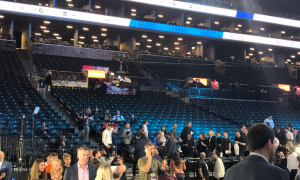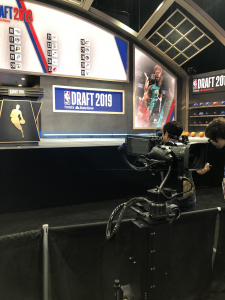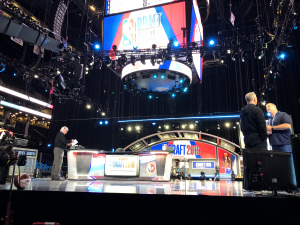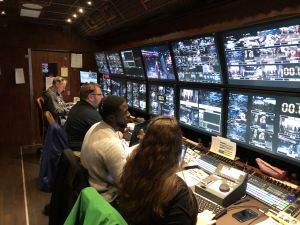Live From the NBA Draft: ESPN Follows Future Stars in Green Room to Backstage With RailCam, Post-Pick Cam
A four-point camera system also flew overhead at the Barclays Center
Story Highlights
If you’re Zion Williamson, you were the first one to hit the stage and shake Commissioner Adam Silver’s hand at the 2019 NBA Draft last night. From nervousness prior to selection to jubilation within the backstage pressroom, ESPN retraced the steps of Zion and the subsequent 59 picks courtesy of a RailCam, a four-point aerial camera system, dedicated RF wireless cameras, and more.
“The NBA is trying to enhance the player green room and where the players are going, so we’re trying to do a better job covering them after they leave [the green room], says Lee Kalinsky, technical operations producer, ESPN. “We can follow these players backstage [on their way to] radio interviews or whoever they’re going to speak with.
The Happiest Walk of Their Lives: End-to-End Coverage
In the past, ESPN has consistently tinkered with an efficient yet intriguing way of recording the drafted player’s figurative transition from amateurism to the professional ranks when his name gets called.
“We’ve always been trying to figure out how to shoot players with regular cameras,” says Kalinsky. “[For prior Drafts], we put Marshall cameras in the player green room. We tried a cue ball [POV[ last year, but you don’t know where everyone is going to sit.”
In 2019, the network decided to deploy a wrinkle usually deployed for live sports productions. Using a technique typically reserved for basketball events, such as CBS and Turner Sports’ production of the NCAA Men’s Basketball Final Four and the Big Ten Tournament, All Mobile Video supplied a Sony P1 with RF capabilities and mounted the camera on a 50-ft. track to slowly run parallel with the stage. The system served a dual purpose, knocking out two production birds with one stone.
“This is the first time we’re using a RailCam at the NBA Draft,” he says. “[The idea] was two-fold because it obviously shows the viewer what’s happening on the stage but it can turn around and show you the players inside of the green room as well.”
With RailCam working on the ground, aerial shots of the entire Draft floor were provided by a four-point camera system that emanated from the rafters. The crew upgraded this setup and moved away from the traditional point-to-point method.
When players ventured from the stage and into the media frenzy, including multiple sets dedicated to social media, the network comprised various teams that followed the players through the circuit with the help of eight RF cameras, including Steadicams and MōVis. Backstage, CP Communications supplied seamless connectivity that withstood the rigors of a packed arena and a cavalcade of media responsibilities. Admiral Video took care of capturing all the backstage activity via Marshall POVs planted in the ceilings of the backstage passageways. To stay connected, the ESPN team leveraged Riedel Communications’ Bolero wireless intercom system.
“We have some really high-powered communications here, so we can follow them anywhere,” says Kalinsky. “All the camera operators can pretty much get wherever they need to be in the building.”
Overall, a total of 35 cameras were dispersed throughout the venue, including a jib camera that followed the players up the stage steps, three Fletcher robos (including one in the corner of the Draft stage that provided the jib camera with another angle), and an additional jib camera positioned outside the arena and used for virtual-reality graphics.
No Sleep ’Til Brooklyn: Familiar Setting at the Barclays Center
Kalinsky and his New York-based team had a little trick up their sleeve to ensure a smooth broadcast. With a calendar full of games that take place in Brooklyn and previous NBA Drafts taking place in the venue since 2013, the Barclays Center is not foreign territory to the people who produced the show.
“[Thanks to] relationships with operations, events, and security staff, the electricians, and different union groups we deal with in the venue, it’s a perfect building to work in. They also know what the NBA folks are looking for,” Kalinsky says. “A lot of this is local knowledge and knowing where to get cable from and where it needs to go.”
One of those folks is Catherine Chalverus, operations producer, ESPN. Out of Kalinsky’s 20 NBA Drafts, she has worked hand-in-hand with him for the past seven. To go about their business with precision, the duo and the rest of the onsite team meticulously worked out every detail of the production. As the event gets bigger and bigger, the staff takes just a bit longer to plan.
“Planning for this takes a very long time,” says Kalinsky. “For my staff and me, it’s a year-long project. We were able to come out and do a couple of surveys [to see] where the RailCam and Fletchers are going to go. We also needed to work out the heights in relationship with the rest of the rigging and the jumbotron. We’ve done Fletchers before that were behind the commissioner, but, as the NBA builds their stuff up more and more, we try keeping up with their progress.”
In the compound, the A and B units of Game Creek Video’s 79 mobile production unit is the heart of technical services. With more than 150 onsite staffers, departments were split in half. In the A unit, audio mixing and the production staff, including ESPN directors Ed Curran (in his 10th NBA Draft) and Jeff Nelson, worked adjacent from each other. The B unit was used strictly by graphics, replay, communications, and virtual-reality teams. The unit houses two eight-channel and three six-channel EVS replay servers and three Viz graphic systems (two for the regular on-air graphics package and one powering the VR template). The offsite team at ESPN’s Bristol, CT, headquarters provided another layer of support. For editing, ESPN had an entire onsite trailer full of Avid devices.
Studio Programming Captures the Moment
As if a full slate of technological offerings weren’t enough, the network showcased its full lineup of NBA-related linear shows from different vantage points. In the arena’s main atrium, The Jump with Rachel Nichols aired from 3 p.m. to 5 p.m. ET. The three-camera shoot, along with interviews on the green carpet behind the physical set, were facilitated via The Switch from the compound to the show’s usual studio home in Los Angeles.
Inside the inner bowl, the network’s Draft analysis was front and center with an expansive set that included a four-person main desk and a touchscreen board that allowed talent to present the night’s boldest predictions. Host Rece Davis was joined by a panel of basketball commentators: analysts Jay Bilas, Chauncey Billups, Mike Schmitz and Bobby Marks and ESPN NBA insider Adrian Wojnarowski. Maria Taylor stood near the stairwell heading off the stage as an event reporter and conducted interviews with the draftees.
Offsite talent joined the fun as well. In New Orleans, reporter Marty Smith performed live hits from a Pelicans watch party to describe the environment before, during, and after their first overall selection.
Linear was not the only entity surrounding the NBA Draft. The technical staff assisted a diverse mix of NBA- and ESPN-affiliated partners that ranged from domestic to international.
“We help out ESPN Radio [with Marc Kestecher and analysts Kara Lawson, P.J. Carlesimo, and Bob Valvano] as much as we can, as well as [our digital partner] Tencent from China,” says Kalinsky. “Since ESPN is a large company, we get phone calls about things that pop up [on the day of the event], so ESPN Brazil is also here.”
Along with The Switch, the network is relying on six outbound paths and four return paths for transmission purposes in 720p with fiber connectivity. As a safety net, a satellite truck and a CAT Entertainment Services backup generator were on hand as well.
From Small to Biggie in Brooklyn: ESPN Pushes the Limit
In its 17th straight year as the lead broadcaster, ESPN blew the lid off the technological cookie jar. Of all the years that Kalinsky has spent on this project, 2019 could signify a massive shift in the production scale of the yearly NBA Draft.
“When I first started, we were in the theater at Madison Square Garden,” he noted. “After the Garden goes under construction, we go to the Prudential Center for a couple of years and now we’re here at the Barclays Center. For the NBA, there are years that there was really a lot of excitement [for the Draft], and this [year is] one of them. You can tell by the amount of coverage that we’re doing. It’s a really huge event for ESPN.”




